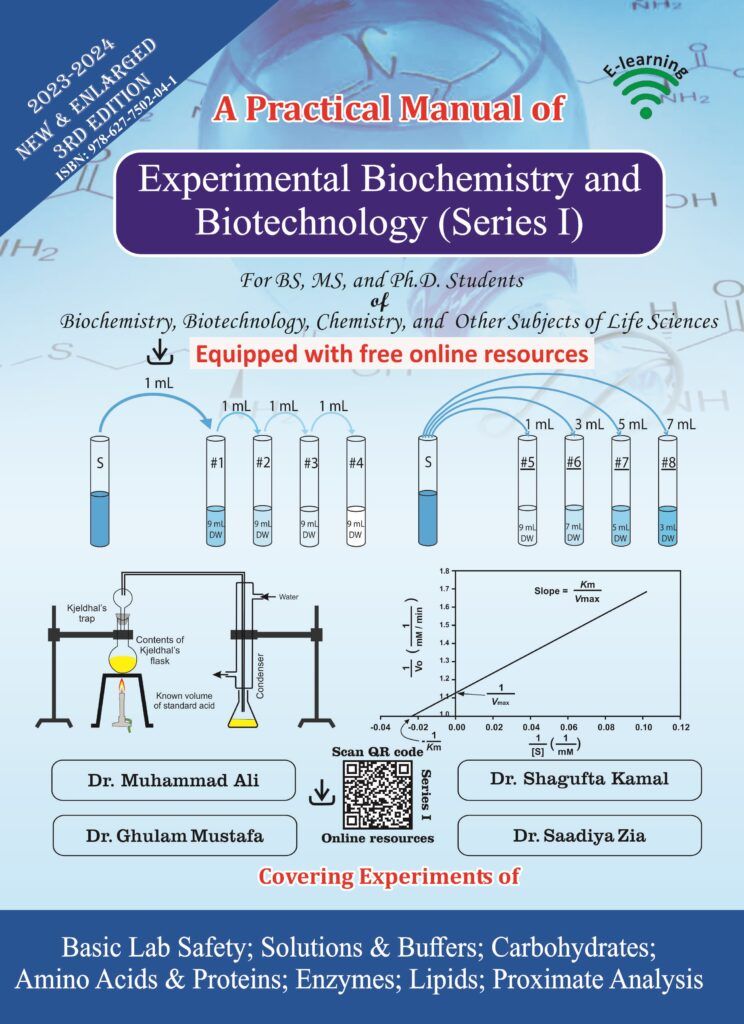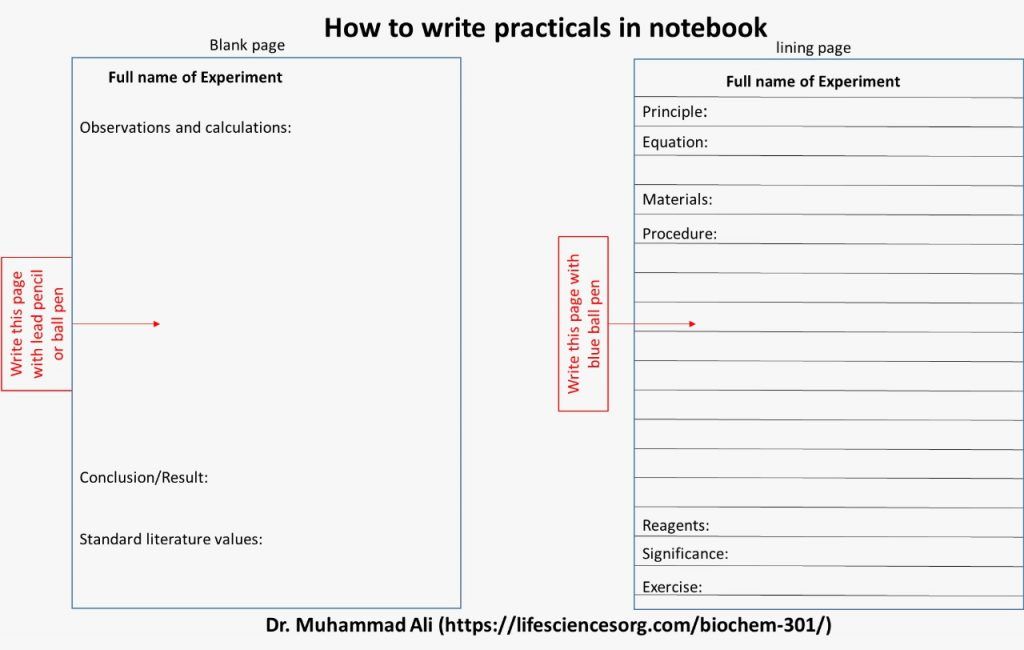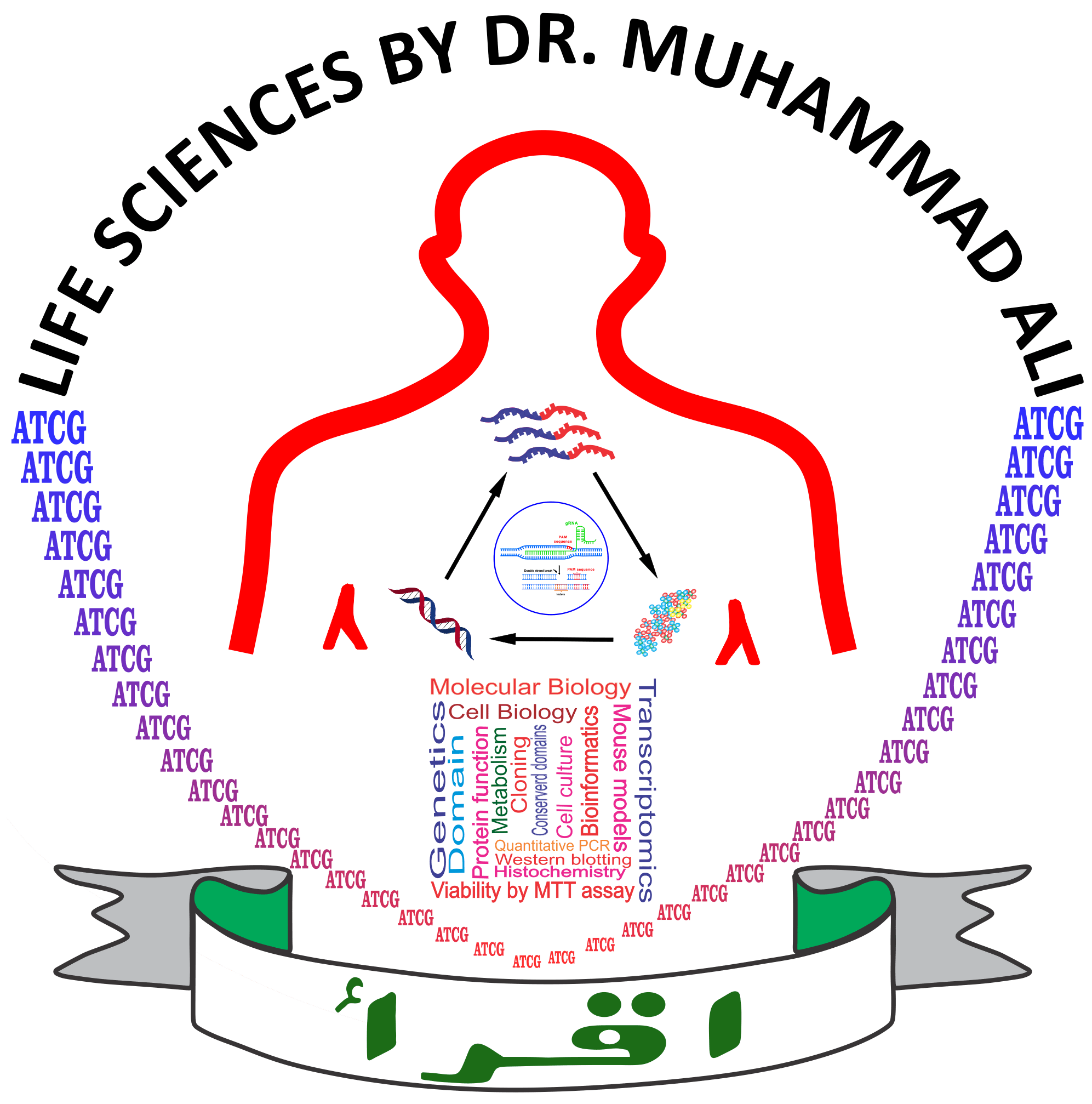Biochem-306 (list of practical) 4(3-1)
Preparation of solutions: Preparation of percentage, molar and normal solutions; Preparation of buffer; (Experiment 2.1, 2.3, 2.4, 2.7-2.9, 2.15, 2.18, 2.19)
Carbohydrate Analysis: Group identification test, Identification of Mono, di and polysaccharides, Identification of reducing sugars, ketose sugar and their confirmation by phenyl hydrazine test, Identification scheme for carbohydrates; (experiments 3.1-3.9)
Quantitative estimation of glucose in blood sample by glucose oxidase method; (experiment 3.12)
Estimation of amino acids by spectrophotometery, Biuret test and ninhydrin test; (4.4, 4.10, 4.11, 4.13)
Precipitation tests of proteins: precipitation of casein at isoelectric point, salt saturation tests, (5.6, 7.11)
serum protein fractionation by ammonium sulfate precipitation; (5.6)
Separation of the colour pigments of berseen/alfalfa by paper chromatography; (4.9)
Identification of lipids. (6.1 to 6.7, 6.14 to 6.15)
Mid-term syllabus of Biochem-306: Introduction to biochemistry; pH & its importance; Buffer: Henderson-Hasselbalch equation; Carbohydrates: Introduction, classification, glycoside linkages & glycosides isomers, optical activity & rotations, chemical properties of monosaccharide, structure and functions of important monosaccharide, Homopolysaccharide, Heteropolysaccharides; Proteins: Introduction, classification; Structure and classification of amino acids, amphoteric properties of amino acids, concept of Isoelectric pH, peptide linkages; Primary, secondary, tertiary and quaternary structure of proteins;
…. PLUS…. 150 MCQs fromeach of chapters 2 (150/302) and chapter -3 (150/729) of the book ” MCQs in Biochemistry”. MCQs from the taught concepts and book chapters will also appear in the exam.
Final exam Biochem-306: Enzymes: General characteristics and classification, enzyme kinetics; Lipids: Introduction, structure and classification of fatty acids, nomenclature of fatty acid, physical properties of fatty acids and triglycerides, chemical properties of fatty acid and triglycerides; Sterols and Cholesterol; Prostaglandin and their physical role; Carbohydrate metabolism: Glycolysis, regulation, energy production, Kreb’s Cycle, regulation, energy production, Electron transport chain, pentose phosphate shunt, gluconeogenesis; Protein metabolism: Degradation of proteins and amino acids; Urea cycle and its importance, urea toxicity, regulation of urea cycle; Bioenergetics of protein metabolism; Lipid metabolism: Beta oxidation of even and odd chain fatty acids, biosynthesis of fatty acids, biosynthesis of triglycerides, biosynthesis of cholesterol, biosynthesis of Ketone bodies; DNA metabolism: Biosynthesis and degradation of nucleic acids; Comparative features among animal species of particular relevance, comparative metabolism of mono-gastric and poly-gastric animals.
…. PLUS…. 150 MCQs from each of chapters 2 (150/302)-3 (150/729), 6 (150/586), 9 (150/621) of the book ” MCQs in Biochemistry”. MCQs from the taught concepts and book chapters will also appear in the exam. The mid-term syllabus will be included in the final exam.
Presentations of Biochem-306:
- The weightage of the assignment and presentation will be decided later.
- Start preparing your presentations……
- The presentations will also be started right after the mid-term exam.
- PPT file should not contain any designing/colours other than figures and diagrams.
- Slides should be in 16X9 ratio.
- Fonts of all header should be same and of all other text should be same.
- For detailed guidelines about the presentation of research article, visit: https://www.lifesciencesorg.combiochem-720/
- Download the template ppt file to make your presentation. The link is here (copy this link and paste in a new tab).
K. General Question to be asked during presentation
- Pathway or importance of gene/technology/discovery
- Rationale
- Conclusion of the full article
- Conclusion of every figure
- New findings presented in the article
- Applications of the findings
- Future prospective
- Applications of the work
- Principle of every technique used in the research article
Moreover, provide me a printed summary of your article containing the above headings given under ‘K’.
L. During Presentations, for EVERY FIGURE and graph, we may ask:
1. The Principle of the experiment.
2. The Reason for doing the experiment.
3. The Physiological importance of the figure.
4. The Conclusions of the figure
5. Prepare well objectively and subjectively
The presentations will also be started after mid-term exam.
NO EXCUSE WILL BE ACCEPTED
__________________________________________________________________________________
Meeting ID: 316 824 288 013
Passcode: WNyjeA
Microsoft teams will be used whenever online classes will be held. You must make your MS teams ID’ s first name as your registration number.
2017-ag-9382 Haidar Iftikhar
2017-ag-10077 Ahmad Faraz
Link to download the book ( MCQs in Biochemistry) is here.
- BIOCHEM-306 INTRODUCTORY BIOCHEMISTRY 4(3 -1)
Course Learning Outcomes
By the end of this course students will be able to;
- Understand basic knowledge about biomolecules carbohydrates, proteins, lipids and nucleic acids
- Learn anabolic and catabolic pathways of carbohydrate, lipid, protein and nucleic acids
- Explain different biochemical assays for the quantitative and qualitative estimation of biomolecules
Theory
Introduction to biochemistry; pH & its importance; Buffer: Henderson-Hasselbalch equation; Carbohydrates: Introduction, classification, glycoside linkages & glycosides isomers, optical activity & rotations, chemical properties of monosaccharide, structure and functions of important monosaccharide, Homopolysaccharide, Heteropolysaccharides; Proteins: Introduction, classification; Structure and classification of amino acids, amphoteric properties of amino acids, concept of Isoelectric pH, peptide linkages; Primary, secondary, tertiary and quaternary structure of proteins; Enzymes: General characteristics and classification, enzyme kinetics; Lipids: Introduction, structure and classification of fatty acids, nomenclature of fatty acid, physical properties of fatty acids and triglycerides, chemical properties of fatty acid and triglycerides; Sterols and Cholesterol; Prostaglandin and their physical role; Carbohydrate metabolism: Glycolysis, regulation, energy production, Kreb’s Cycle, regulation, energy production, Electron transport chain, pentose phosphate shunt, gluconeogenesis; Protein metabolism: Degradation of proteins and amino acids; Urea cycle and its importance, urea toxicity, regulation of urea cycle; Bioenergetics of protein metabolism; Lipid metabolism: Beta oxidation of even and odd chain fatty acids, biosynthesis of fatty acids, biosynthesis of triglycerides, biosynthesis of cholesterol, biosynthesis of Ketone bodies; DNA metabolism: Biosynthesis and degradation of nucleic acids; Comparative features among animal species of particular relevance, comparative metabolism of mono-gastric and poly-gastric animals.
Practical
Preparation of solutions: Preparation of percentage, molar and normal solutions; Preparation of buffer; Carbohydrate Analysis: Group identification test, Identification of Mono, di and polysaccharides, Identification of reducing sugars, ketose sugar and their confirmation by phenyl hydrazine test, Identification scheme for carbohydrates; Quantitative estimation of glucose in blood sample by glucose oxidase method; Estimation of amino acids by spectrophotometery, Biuret test and ninhydrin test; Precipitation tests of proteins: precipitation of casein at isoelectric point, salt saturation tests, serum protein fractionation by ammonium sulfate precipitation; Separation of the colour pigments of berseen/alfalfa by paper chromatography; Identification of lipids.
Suggested Readings
- Berg, J.M, L. J. Tymoczko, G.J. Gatto and L. Stryer. 2019. Biochemistry. 9th Ed. W.H. Freeman and Co., New York, USA
- Boyer, R. 2012. Modern Experimental Biochemistry. 4th Ed. (LPE). Pearson Education, New Delhi, India.
- Murray, R., D. Bender, K.M. Botham, P.I. Kennelly, V. Rodwell and P.A. Weil. 2012. Harper’s Issustrated Biochemistry. 29th Ed. The McGraw-Hill Companies Inc. New York, USA.
- Nelson, D.L and M.M. Cox. 2021. Lehninger Principles of Biochemistry. 8th Ed. WH Freeman & Company, New York, USA.
- Nigram, A. and A. Ayyagari. 2007. Lab Manual in Biochemistry, Immunology and Biotechnology. Tata McGraw-Hill Publishing Company Limited, New Dehli, India.
- Ali, M. et al., Experimental Biochemistry and Biotechnology (Series I), 2023, 3rd edition, ISBN: 978-969-7502-04-1.
- Ali, M. et al., Experimental Biochemistry and Biotechnology (Series II), 2023. 2nd edition, ISBN: 978-969-7502-05-8.
- Ali, M. et al., Experimental Biochemistry and Biotechnology (Series III), 2024, 1st edition, ISBN: 978-969-7502-06-5.
| Biochem-306, BS Micro, E-Winter 2023-24, Dr. Muhammad Ali | ||||
| Sr. | Ag No. | Student’s Name | Group | Research article for presentation and 1 page summary |
| 1 | NOOR FATIMA | MUHAMMAD AMIN | G1 | A patch of positively charged residues regulates the efficacy of clinical DR5 antibodies in solid tumors |
| 2 | MARYAM NAEEM | MUHAMMAD NAEEM JAVED | ||
| 3 | MUHAMMAD IBRAHIM | MUHAMMAD NADEEM | ||
| 4 | MARYAM LARAIB | ASIM RIAZ | ||
| 5 | MUHAMMAD AHMED HABIB | MUHAMMAD SHAHID HABIB | ||
| 6 | ANAM TARIQ | MUHAMMAD TARIQ | G2 | Preclinical evaluation of a novel antibody-drug conjugate targeting DR5 for lymphoblastic leukemia therapy |
| 7 | MISHAAL | KAMRAN | ||
| 8 | ANAS ROHAIL | IKHLAQ AHMAD | ||
| 9 | AMINA SALEEM | MUHAMMAD SALEEM | ||
| 10 | FATIMA NOOR UL AIN | ALTAF HUSSAIN | ||
| 11 | M. USMAN ARSHAD | MUHAMMAD ARSHAD | G3 | A highly stable human single-domain antibody-drug conjugate exhibits superior penetration and treatment of solid tumors |
| 12 | RUBAB HUSAIN AWAN | SHAFQUAT HUSSAIN AWAN | ||
| 13 | DUR-E-MAKNOON | MUHAMMAD SHAHZAD | ||
| 14 | FAIZAAN AMJAD | AMJAD HUSSAIN | ||
| 15 | AHMAD TALAL SHAHID | SHAHID HUSSAIN | ||
| 16 | AMEER HAMZA BAIG | ABDUL MAJEED | G4 | Eradication of Triple-Negative Breast Cancer Cells by Targeting Glycosylated PD-L1 |
| 17 | ATTIA AMTUL KARIM LUBNA | WAHEED AHMAD | ||
| 18 | TANIA MASOOD | PERVAIZ MASOOD | ||
| 19 | MUNTAHA WAQAS | CH. WAQAS ZUBAIR | ||
| 20 | SAMEEN IRFAN | IRFAN AKBAR CH. | ||
| 21 | FATIMA IMRAN | IMRAN ZAFAR | G5 | Mesoporous Silica Nanoparticles as Drug Delivery Systems for Targeted Inhibition of Notch Signaling in Cancer |
| 22 | MISBAH UR REHMAN | ABDUL REHMAN | ||
| 23 | AROOJ FATIMA | MUHAMMAD FARHAT ASIM | ||
| 24 | FATIMA IMTIAZ | IMTIAZ SAFDAR CHEEMA | ||
| 25 | MAHNOOR MURTAZA | MUHAMMAD MURTAZA | ||
| 26 | SANA RIAZ | MUHAMMAD RIAZ | G6 | L-Arginine Modulates T Cell Metabolism and Enhances Survival and Anti-tumor Activity |
| 27 | WAJIHA ZAHID | ABDUL ZAHID | ||
| 28 | SAMAIKA NOOR | MUHAMMAD SHAFIQUE | ||
| 29 | FATIMA BILAL | BILAL ILLYAS | ||
| 30 | MARYAM LIAQUAT ALI | LIAQUAT ALI | ||
| 31 | SAHAR REHMAN | REHMAN SALEEM | G7 | BMP4 Upregulation Is Associated with Acquired Drug Resistance and Fatty Acid Metabolism in EGFR-Mutant Non-Small-Cell Lung Cancer Cells |
| 32 | ABDUL RAUF | KHADIM HUSSAIN | ||
| 33 | MUHAMMAD RIZWAN SHAHID | MUHAMMAD SHAHID TAJ | ||
| 34 | ALISHBA KAMAL | KAMAL AKBAR | ||
| 35 | NIMRA AZEEM | MUHAMMAD AZEEM | ||
| 36 | ASIM AHMAD SALEEM | MUHAMMAD SALEEM | G8 | The topoisomerase inhibitor CPT-11 prevents the growth and metastasis of lung cancer cells in nude mice by inhibiting EGFR/ MAPK signaling pathway |
| 37 | HAFIZA SIDRA BUSHRA | MEHMOOD AHMAD | ||
| 38 | ABAID UL REHMAN ARIF | ZULFIQAR ALI | ||
| 39 | WANIA | M.IMRAN | ||
| 40 | IZZA | SHAHZAD ISHAQ | ||
| 41 | MUHAMMAD BIN MANSHAD | MANSHAD AHMAD | G9 | Identification of actionable targets for breast cancer intervention using a diversity outbred mouse model |
| 42 | Bilal hasan chema | |||
| 43 | Abaid | |||
| 44 | Ali haider | |||
| 45 | Wajiha maqsood | |||
| 46 | Tayyaba sharif | G10 | ZNF451 favors triple-negative breast cancer progression by enhancing SLUG-mediated CCL5 transcriptional expression | |
| 47 | Sawaira Arshad | |||
| 48 | Rimsha Ishtiaq | |||
| 49 | Izza | |||
| 50 | Saika noreen | |||
| 51 | Wajeeha Amjad | |||
| 52 | Sehar Bano | |||
| 53 | ||||
| 54 | ||||
| 55 | ||||




Comments are closed.